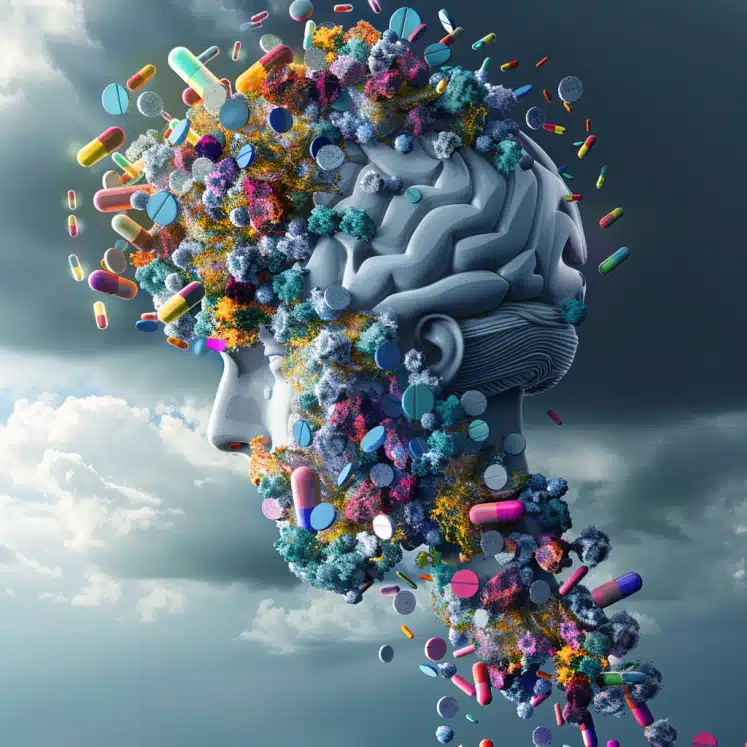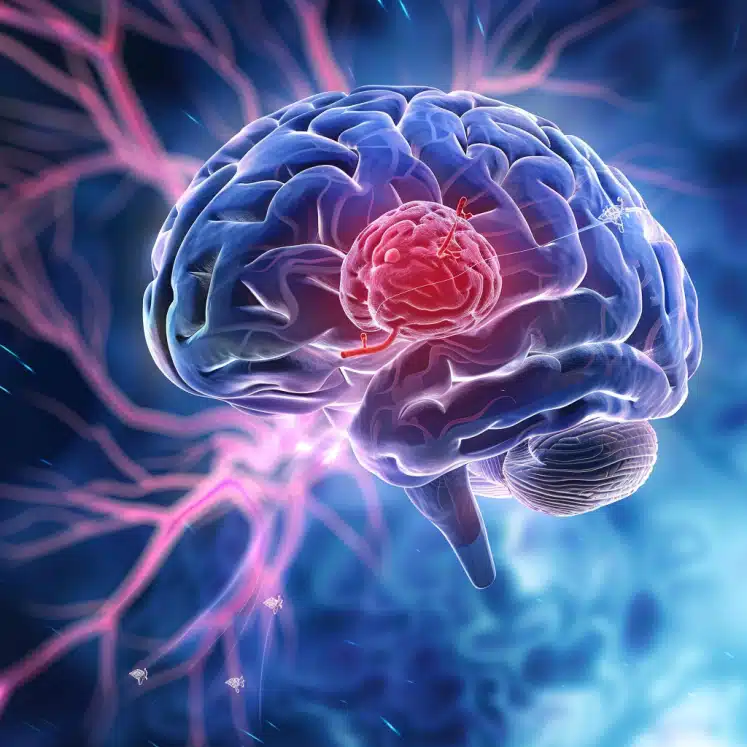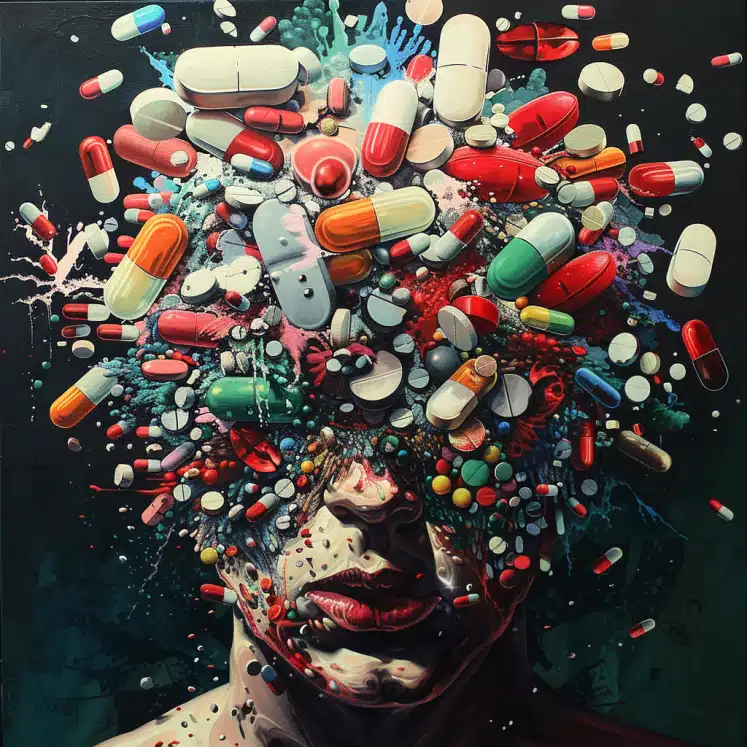Repurposing antipsychotics and antidepressants with favorable safety profiles and blood-brain barrier permeability shows promise for glioblastoma (GBM) treatment, primarily through disrupting lysosomal function and inducing cell death.
Highlights:
- Mechanism of Action: The studied antipsychotics and antidepressants induce GBM cell death by disrupting lysosomal function, leading to lysosomal membrane rupture.
- PTEN Sensitivity: GBMs with intact PTEN are more sensitive to these drugs, while PTEN-deficient GBMs show increased sensitivity when combined with EGFR-PI3K-Akt pathway inhibitors.
- Drug Synergy: Inhibition of lysosomal function by these CNS drugs synergizes with inhibitors targeting the EGFR-PI3K-Akt pathway, causing energetic and antioxidant collapse in GBM cells.
- Clinical Potential: The study provides a foundation for the potential clinical use of CNS drugs in GBM treatment and offers insights into the mechanisms behind their cytotoxicity.
Source: Cell Death & Disease (2024)
Glioblastoma (Overview): Causes, Symptoms, Treatment
Glioblastoma (GBM) is an aggressive type of brain cancer that originates from glial cells, which support and protect neurons in the brain.
The exact causes of GBM are not well understood, but several factors may contribute:
- Genetic Mutations: Mutations in genes such as TP53, EGFR, and PTEN are commonly found in GBM tumors. These mutations can lead to uncontrolled cell growth and cancer development.
- Environmental Factors: Exposure to ionizing radiation, such as previous radiation therapy for other cancers, is a known risk factor.
- Age & Sex: GBM is more common in older adults and tends to occur slightly more often in men than in women.
- Family History: Although rare, a family history of certain genetic syndromes can increase the risk of developing GBM.
Symptoms
The symptoms of glioblastoma can vary depending on the tumor’s size, location, and rate of growth.
Common symptoms include:
- Headaches: Often severe and persistent, particularly in the morning.
- Seizures: New onset seizures can be a sign of GBM.
- Cognitive Changes: Memory loss, difficulty concentrating, and changes in personality or behavior.
- Neurological Deficits: Weakness or numbness in parts of the body, difficulty with balance and coordination, and speech difficulties.
- Visual Changes: Blurred vision or loss of vision, depending on the tumor’s location in the brain.
Current Treatments in 2024
Treatment for glioblastoma typically involves a combination of therapies aimed at removing or reducing the tumor and managing symptoms.
Common treatments include:
- Surgery: The first line of treatment is usually surgical resection to remove as much of the tumor as possible. Complete removal is often challenging due to the tumor’s diffuse and infiltrative nature.
- Radiation Therapy: Following surgery, radiation therapy is used to target and kill remaining cancer cells. It helps to control the growth of the tumor and extend survival.
- Chemotherapy: The most commonly used chemotherapy drug for GBM is temozolomide (TMZ), which is often administered concurrently with radiation therapy and continued afterward.
- Targeted Therapy: Bevacizumab, a drug that inhibits blood vessel growth (angiogenesis), is sometimes used to treat recurrent GBM.
- Tumor Treating Fields (TTF): A newer therapy that uses electric fields to disrupt cancer cell division, often used in combination with other treatments.
Prognosis
Glioblastoma has a poor prognosis, with an average survival time of 10 to 15 months after diagnosis.
Factors influencing prognosis include:
- Extent of Surgical Resection: Patients who undergo a more complete surgical removal of the tumor tend to have better outcomes.
- Patient Age and Health: Younger patients and those in better overall health generally fare better.
- Molecular Markers: Certain genetic and molecular features, such as MGMT promoter methylation and IDH1 mutations, can influence response to treatment and overall survival.
- Recurrence: GBM has a high recurrence rate, which significantly impacts survival and quality of life.
Main Findings: Repurposing CNS Drugs for Glioblastoma Treatment (2024)

1. Mechanism of Action: Disruption of Lysosomal Function
The study discovered that certain antipsychotics and antidepressants, which were originally developed for central nervous system (CNS) disorders, can kill glioblastoma (GBM) cells by disrupting the function of lysosomes.
Lysosomes are tiny organelles within cells that break down waste materials and cellular debris.
These drugs accumulate in the lysosomes, leading to their malfunction.
Over time, this buildup causes the lysosomal membrane to rupture, spilling harmful enzymes into the cell and ultimately leading to cell death.
This mechanism is significant because it offers a new way to target and kill GBM cells, which are typically very resilient to standard treatments.
2. Enhanced Sensitivity in PTEN Intact GBMs
GBM cells with an intact PTEN gene are more sensitive to these CNS drugs. PTEN is a tumor suppressor gene that helps regulate cell growth by inhibiting the PI3K-Akt signaling pathway, which is often overactive in cancer cells.
In this study, it was found that when GBM cells have a functional PTEN gene, they are more vulnerable to the lysosomal disruption caused by the drugs.
This suggests that patients with PTEN-intact GBM might respond better to treatment with these repurposed CNS drugs.
3. Synergy with EGFR-PI3K-Akt Pathway Inhibitors
For GBM cells lacking a functional PTEN gene, combining CNS drugs with inhibitors of the EGFR-PI3K-Akt pathway significantly increases their effectiveness.
The EGFR-PI3K-Akt pathway is crucial for cell survival and proliferation.
By simultaneously blocking this pathway and disrupting lysosomal function, the combined treatment causes a collapse of the cell’s energy production and antioxidant defenses, leading to cell death.
This finding is important because it suggests a combination therapy approach that could be more effective than using either treatment alone.
4. Clinical Potential of CNS Drugs
The study highlights the potential of repurposing FDA-approved CNS drugs, such as certain antipsychotics and antidepressants, for treating GBM.
These drugs are attractive candidates because they already have established safety profiles and can cross the blood-brain barrier, a significant hurdle in brain cancer treatment.
By repurposing these drugs, it could be possible to develop new GBM therapies more quickly and cost-effectively than creating new drugs from scratch.
5. Predicting Anti-GBM Activity Based on Chemical Properties
The study found that the anti-GBM activity of CNS drugs can be predicted based on certain chemical properties, such as lipophilicity (ability to dissolve in fats) and weak base characteristics.
Drugs with high lipophilicity and weak base properties are more likely to accumulate in lysosomes and disrupt their function.
This insight can guide the selection of other CNS drugs for repurposing in cancer therapy, potentially expanding the arsenal of treatments available for GBM and other cancers.
How Antipsychotics May Treat Glioblastoma: Specific Mechanisms

1. Disruption of Lysosomal Function
Antipsychotics accumulate within the lysosomes of glioblastoma (GBM) cells, leading to their malfunction.
Lysosomes are cellular organelles responsible for breaking down waste materials and cellular debris.
The buildup of antipsychotics in lysosomes disrupts their acidic environment, which is essential for their digestive function.
This disruption causes lysosomal membrane permeabilization (LMP), leading to the release of digestive enzymes into the cytoplasm, which then triggers cell death.
This mechanism is crucial because it targets a fundamental aspect of cell maintenance and survival.
2. Induction of Lysosomal Membrane Permeabilization (LMP)
The accumulation of antipsychotics in lysosomes induces LMP, a process where the lysosomal membrane becomes compromised.
This permeabilization allows lysosomal contents, including catabolic enzymes such as cathepsin D, to spill into the cytosol.
The release of these enzymes into the cytoplasm can cause extensive cellular damage and trigger various forms of cell death, including apoptosis, necrosis, and autophagy-dependent cell death.
This specific mechanism exploits the vulnerability of GBM cells to lysosomal disruption.
3. Inhibition of the EGFR-PI3K-Akt Pathway
Antipsychotics, particularly in combination with inhibitors targeting the EGFR-PI3K-Akt pathway, can effectively enhance GBM cell death.
The EGFR-PI3K-Akt pathway is crucial for cell survival, growth, and proliferation. In GBM cells, this pathway is often hyperactivated, promoting tumor growth and resistance to therapy.
By inhibiting this pathway, antipsychotics can reduce cell survival signals.
When combined with lysosomal disruption, this inhibition leads to a collapse in cellular energy production and redox balance, further driving the cells toward death.
4. Synergistic Effects with PTEN Status
The effectiveness of antipsychotics is significantly influenced by the status of the PTEN gene in GBM cells.
PTEN is a tumor suppressor that negatively regulates the PI3K-Akt signaling pathway.
GBM cells with intact PTEN are more sensitive to the cytotoxic effects of antipsychotics.
In PTEN-deficient GBM cells, combining antipsychotics with inhibitors of the EGFR-PI3K-Akt pathway can enhance their sensitivity to treatment.
This combined approach leads to a more substantial disruption of cellular homeostasis and promotes cell death.
5. Autophagy & Endocytic Pathway Disruption
Antipsychotics interfere with autophagy, a cellular process that degrades and recycles damaged cell components.
They increase the levels of LC3 II and p62, markers of autophagic activity, indicating a blockage of autophagic flux.
This blockage occurs after autophagosomes fuse with lysosomes but before the autophagic cargo is degraded.
Additionally, antipsychotics disrupt the endocytic pathway, causing an accumulation of receptors and endosomal markers within the cells.
This disruption impedes the cells’ ability to recycle surface receptors and maintain cellular homeostasis, contributing to cell death.
Study Overview: Antipsychotics & Antidepressants in Glioblastoma Cell Lines & Animal Models (2024)
The primary aim of the study was to investigate the potential of repurposing FDA-approved antipsychotics and antidepressants for the treatment of glioblastoma (GBM), focusing on their mechanisms of action and effectiveness in vitro (in the lab) and in vivo (in living organisms).
Sample
- Cell Lines: Various GBM cell lines, including commercially available lines (U87-MG, A172, T98G, U118-MG, LN18) and patient-derived lines (OSU2, OSU61, ACPK1, ACPK4, ACPK8).
- Animal Models: Nude mice intracranially implanted with U87-MG-Luc2 cells to create GBM models for in vivo testing.
Methods
- Cytotoxicity Screens: Identified the anti-GBM activity of first and second-generation antipsychotics using viability assays.
- Mechanism Investigation: Assessed the impact of drugs on lysosomal function, including lysosomal acidity and enzymatic activity measurements.
- Genetic Manipulations: Used isogenic cell lines to study the role of PTEN status in drug sensitivity.
- Combination Therapy: Tested the synergistic effects of combining CNS drugs with EGFR-PI3K-Akt pathway inhibitors.
- In Vivo Testing: Monitored tumor growth and survival in mice treated with perphenazine.
Limitations
- In Vitro Focus: While the study provided detailed in vitro data, the complexity of human GBM may not be fully replicated in cell lines.
- Animal Models: Results in mice may not directly translate to humans due to biological differences.
- Drug Specificity: The study focused on a select group of antipsychotics and antidepressants, so findings may not apply to all CNS drugs.
- PTEN Status: Variability in PTEN expression among different patients’ tumors could affect the generalizability of results.
- Long-Term Effects: The long-term safety and efficacy of these repurposed drugs in humans remain to be thoroughly evaluated.
Conclusion: Antipsychotics & Antidepressants for Glioblastoma
This study highlights the promising potential of repurposing antipsychotics and antidepressants for the treatment of glioblastoma (GBM).
By disrupting lysosomal function and inducing lysosomal membrane permeabilization, these drugs effectively trigger cell death in GBM cells.
Additionally, the sensitivity of GBM cells to these drugs is enhanced when combined with inhibitors targeting the EGFR-PI3K-Akt pathway, particularly in cells with intact PTEN status.
These findings provide a strong foundation for further clinical investigations and suggest a novel therapeutic strategy that leverages the established safety profiles and blood-brain barrier permeability of these CNS drugs.
Overall, this research offers critical insights into the mechanisms of drug action and opens new avenues for the development of effective GBM treatments.
References
- Study: Antipsychotics possess anti-glioblastoma activity by disrupting lysosomal function and inhibiting oncogenic signaling by stabilizing PTEN (2024)
- Authors: John Ryan Jacob et al.







